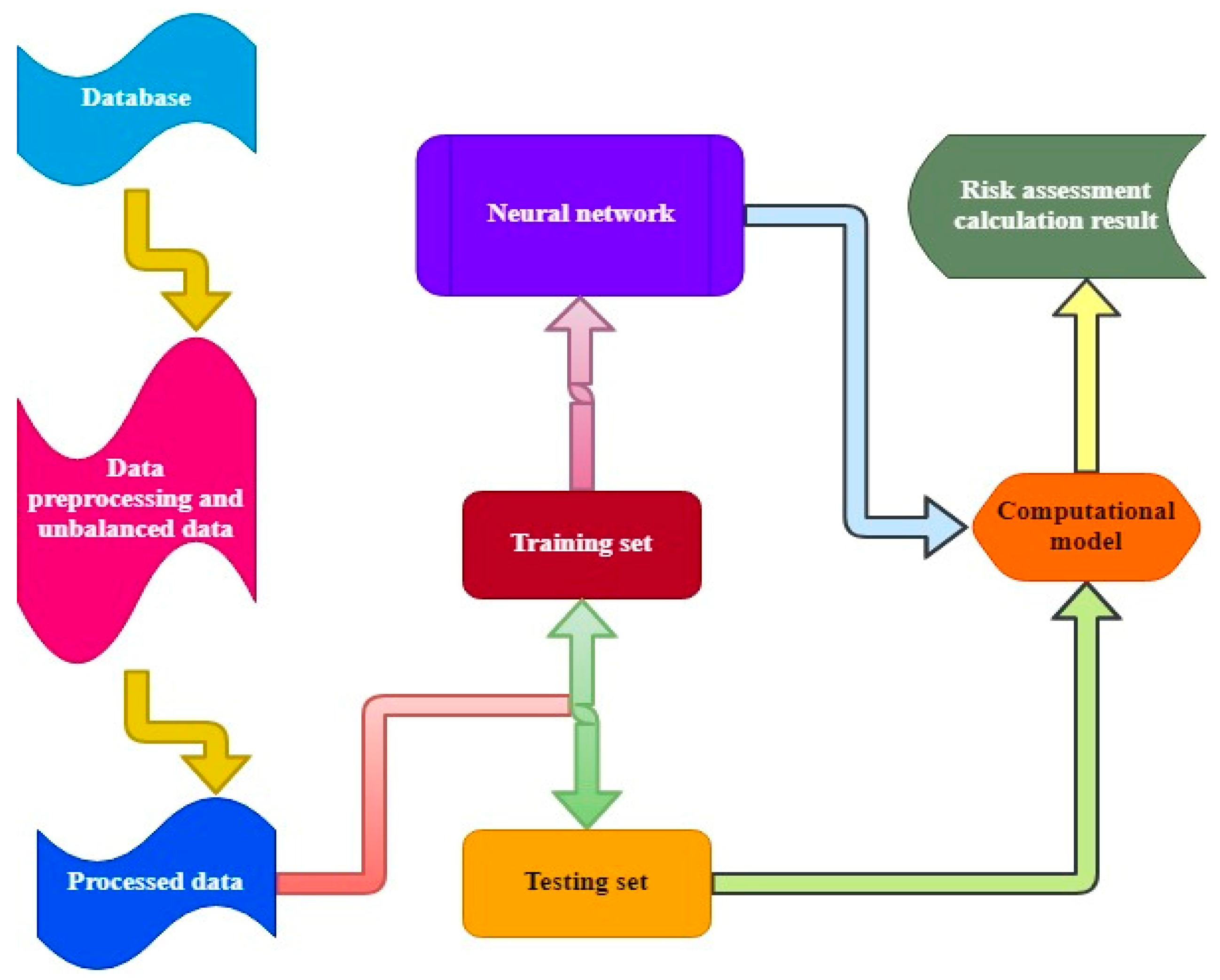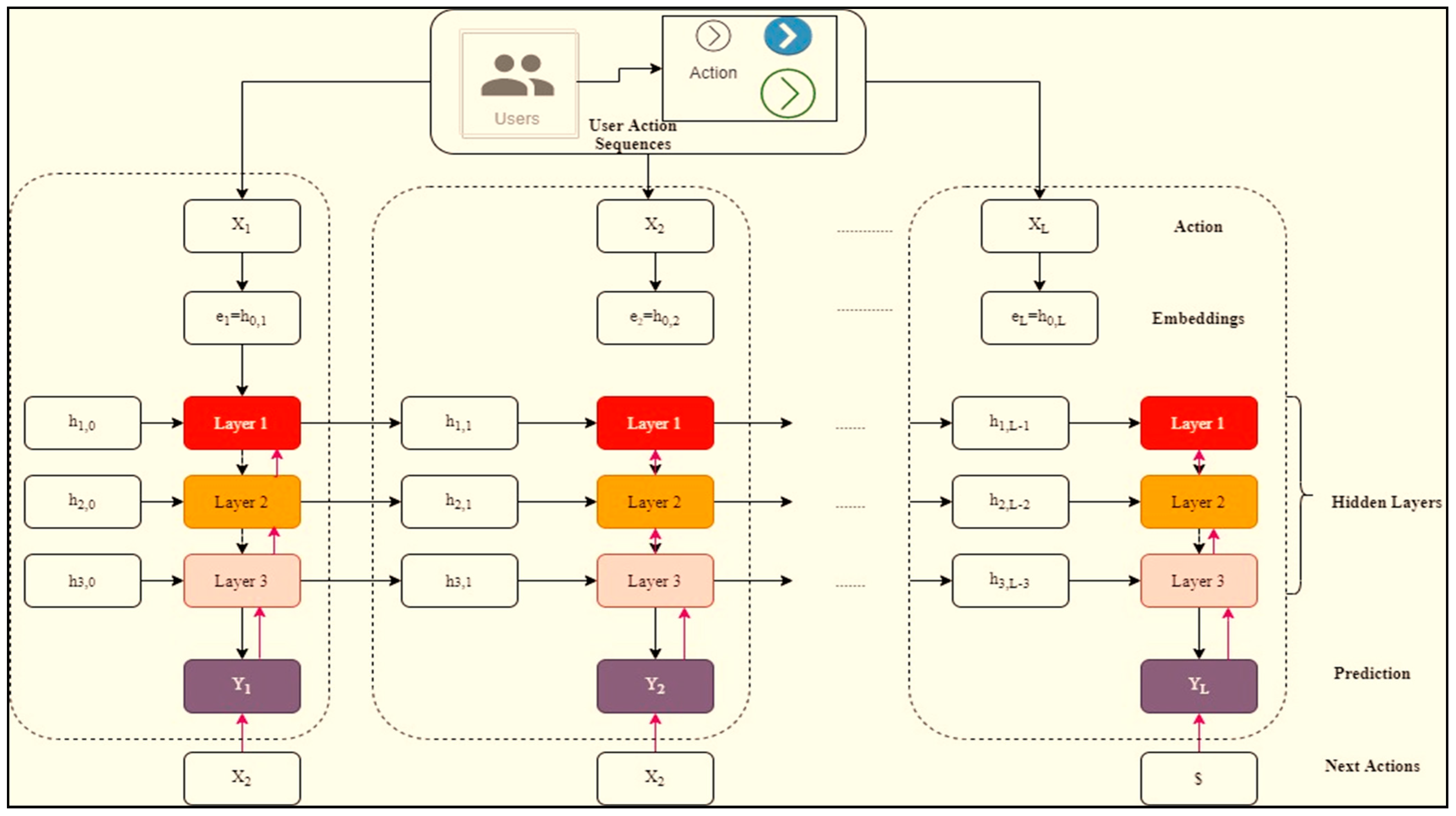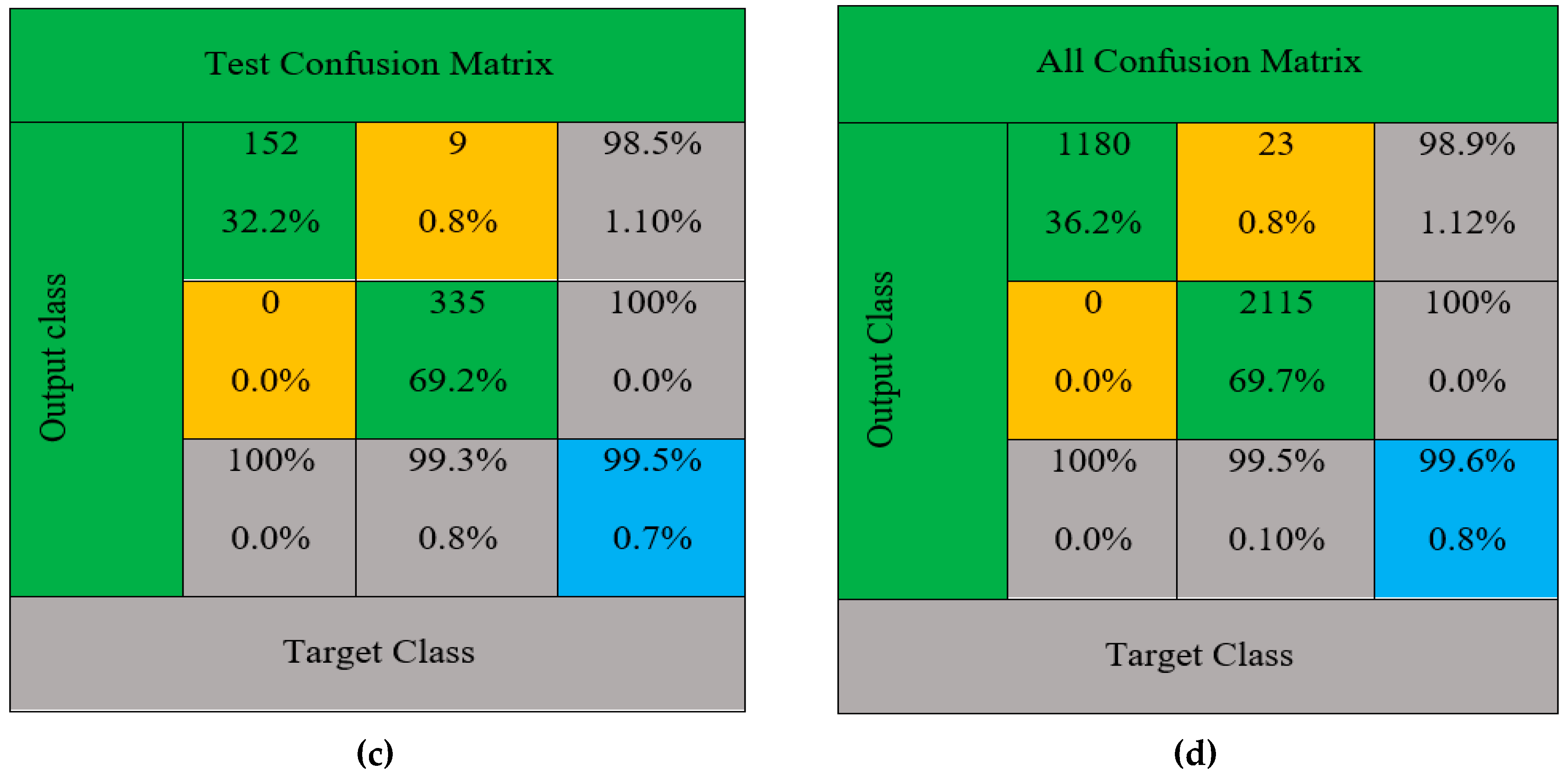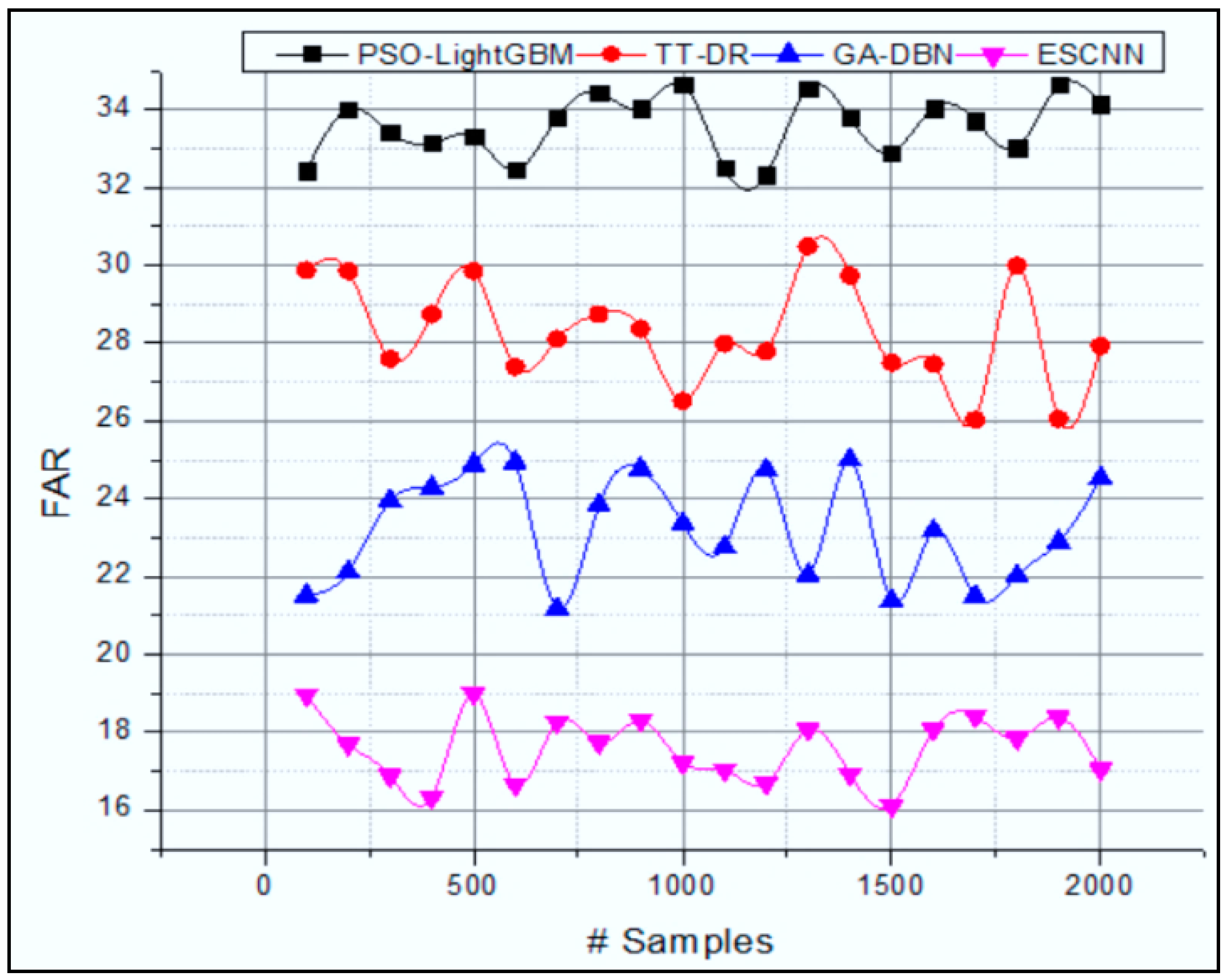Threat Analysis and Distributed Denial of Service (DDoS) Attack Recognition in the Internet of Things (IoT)
Abstract
1. Introduction
- Security and privacy concerns were a problem in this IoT paradigm because of threats and attacks.
- This IoT paradigm was plagued by security and privacy concerns due to intrusion threats and attacks.
- The use of training patterns in the network successfully classifies the standard and the threats.
2. Related Work
3. Materials and Methods
Intrusion Detection Using Optimized Sparse Convolution Neural Networks
| Algorithm 1: |
| Start |
| Output parameter; |
| do |
| ; |
| Re-estimate variables |
| End for; |
| ; |
| End; |
| Return; |
| Print parameter value; |
| Stop |
4. Results and Discussion
5. Conclusions
Author Contributions
Funding
Institutional Review Board Statement
Informed Consent Statement
Data Availability Statement
Conflicts of Interest
Table of Abbreviations
| NTP | Network time protocol |
| LDAP | Lightweight directory access protocol |
| DNS | Domain name system |
| NetBIOS | Network Basic Input/Output System |
| MSSQL | Microsoft SQL Server |
| TFTP | Trivial File Transfer Protocol |
References
- Saba, T.; Haseeb, K.; Ahmed, I.; Rehman, A. Secure and energy-efficient framework using Internet of Medical Things for e-healthcare. J. Infect. Public Health 2020, 13, 1567–1575. [Google Scholar] [CrossRef]
- Awan, M.J.; Masood, O.A.; Mohammed, M.A.; Yasin, A.; Zain, A.M.; Damaševičius, R.; Abdulkareem, K.H. Image-Based Malware Classification Using VGG19 Network and Spatial Convolutional Attention. Electronics 2021, 10, 2444. [Google Scholar] [CrossRef]
- Noshad, Z.; Javaid, N.; Saba, T.; Wadud, Z.; Saleem, M.Q.; Alzahrani, M.E.; Sheta, O.E. Fault Detection in Wireless Sensor Networks through the Random Forest Classifier. Sensors 2019, 19, 1568. [Google Scholar] [CrossRef]
- Ahmad, A.M.; Sulong, G.; Rehman, A.; Alkawaz, M.H.; Saba, T. Data Hiding Based on Improved Exploiting Modification Direction Method and Huffman Coding. J. Intell. Syst. 2014, 23, 451–459. [Google Scholar] [CrossRef]
- Javaid, S.; Javaid, N.; Saba, T.; Wadud, Z.; Rehman, A.; Haseeb, A. Intelligent Resource Allocation in Residential Buildings Using Consumer to Fog to Cloud Based Framework. Energies 2019, 12, 815. [Google Scholar] [CrossRef]
- Hussain, M.; Javed, W.; Hakeem, O.; Yousafzai, A.; Younas, A.; Awan, M.J.; Nobanee, H.; Zain, A.M. Blockchain-Based IoT Devices in Supply Chain Management: A Systematic Literature Review. Sustainability 2021, 13, 13646. [Google Scholar] [CrossRef]
- Rehman, A.; Haseeb, K.; Saba, T.; Lloret, J.; Ahmed, Z. Mobility Support 5G Architecture with Real-Time Routing for Sustainable Smart Cities. Sustainability 2021, 13, 9092. [Google Scholar] [CrossRef]
- Saba, T.; Rehman, A.; Latif, R.; Fati, S.M.; Raza, M.; Sharif, M. Suspicious Activity Recognition Using Proposed Deep L4-Branched-Actionnet With Entropy Coded Ant Colony System Optimization. IEEE Access 2021, 9, 89181–89197. [Google Scholar] [CrossRef]
- Haseeb, K.; Almustafa, K.M.; Jan, Z.; Saba, T.; Tariq, U. Secure and Energy-Aware Heuristic Routing Protocol for Wireless Sensor Network. IEEE Access 2020, 8, 163962–163974. [Google Scholar] [CrossRef]
- Awan, M.J.; Farooq, U.; Babar, H.M.A.; Yasin, A.; Nobanee, H.; Hussain, M.; Hakeem, O.; Zain, A.M. Real-Time DDoS Attack Detection System Using Big Data Approach. Sustainability 2021, 13, 10743. [Google Scholar] [CrossRef]
- Saba, T.; Haseeb, K.; Din, I.U.; Almogren, A.; Altameem, A.; Fati, S.M. EGCIR: Energy-Aware Graph Clustering and Intelligent Routing Using Supervised System in Wireless Sensor Networks. Energies 2020, 13, 4072. [Google Scholar] [CrossRef]
- Rashid, M.; Khan, M.A.; Alhaisoni, M.; Wang, S.-H.; Naqvi, S.R.; Rehman, A.; Saba, T. A Sustainable Deep Learning Framework for Object Recognition Using Multi-Layers Deep Features Fusion and Selection. Sustainability 2020, 12, 5037. [Google Scholar] [CrossRef]
- Ferooz, F.; Hassan, M.T.; Awan, M.J.; Nobanee, H.; Kamal, M.; Yasin, A.; Zain, A.M. Suicide Bomb Attack Identification and Analytics through Data Mining Techniques. Electronics 2021, 10, 2398. [Google Scholar] [CrossRef]
- Khan, A.Y.; Latif, R.; Latif, S.; Tahir, S.; Batool, G.; Saba, T. Malicious Insider Attack Detection in IoTs Using Data Analytics. IEEE Access 2019, 8, 11743–11753. [Google Scholar] [CrossRef]
- Saba, T.; Haseeb, K.; Shah, A.A.; Rehman, A.; Tariq, U.; Mehmood, Z. A Machine-Learning-Based Approach for Autonomous IoT Security. IT Prof. 2021, 23, 69–75. [Google Scholar] [CrossRef]
- Ali, S.F.; Aslam, A.S.; Awan, M.J.; Yasin, A.; Damaševičius, R. Pose Estimation of Driver’s Head Panning Based on Interpolation and Motion Vectors under a Boosting Framework. Appl. Sci. 2021, 11, 11600. [Google Scholar] [CrossRef]
- Saba, T.; Sadad, T.; Rehman, A.; Mehmood, Z.; Javaid, Q. Intrusion Detection System Through Advance Machine Learning for the Internet of Things Networks. IT Prof. 2021, 23, 58–64. [Google Scholar] [CrossRef]
- Odusami, M.; Misra, S.; Adetiba, E.; Abayomi-Alli, O.; Damasevicius, R.; Ahuja, R. An Improved Model for Alleviating Layer Seven Distributed Denial of Service Intrusion on Webserver. J. Physics Conf. Ser. 2019, 1235. [Google Scholar] [CrossRef]
- Saba, T. Intrusion Detection in Smart City Hospitals using Ensemble Classifiers. In Proceedings of the 2020 13th International Conference on Developments in eSystems Engineering (DeSE), Liverpool, UK, 14–17 December 2020; pp. 418–422. [Google Scholar]
- Mujahid, A.; Awan, M.; Yasin, A.; Mohammed, M.; Damaševičius, R.; Maskeliūnas, R.; Abdulkareem, K. Real-Time Hand Gesture Recognition Based on Deep Learning YOLOv3 Model. Appl. Sci. 2021, 11, 4164. [Google Scholar] [CrossRef]
- Ali, M.H.; Jaber, M.M.; Abd, S.K.; Rehman, A.; Awan, M.J.; Vitkutė-Adžgauskienė, D.; Damaševičius, R.; Bahaj, S.A. Harris Hawks Sparse Auto-Encoder Networks for Automatic Speech Recognition System. Appl. Sci. 2022, 12, 1091. [Google Scholar] [CrossRef]
- Haafza, L.A.; Awan, M.J.; Abid, A.; Yasin, A.; Nobanee, H.; Farooq, M.S. Big Data COVID-19 Systematic Literature Review: Pandemic Crisis. Electronics 2021, 10, 3125. [Google Scholar] [CrossRef]
- Awan, M.J.; Yasin, A.; Nobanee, H.; Ali, A.A.; Shahzad, Z.; Nabeel, M.; Zain, A.M.; Shahzad, H.M.F. Fake News Data Exploration and Analytics. Electronics 2021, 10, 2326. [Google Scholar] [CrossRef]
- Rehman, A.; Haseeb, K.; Saba, T.; Lloret, J.; Sendra, S. An Optimization Model with Network Edges for Multimedia Sensors Using Artificial Intelligence of Things. Sensors 2021, 21, 7103. [Google Scholar] [CrossRef]
- Rehman, A.; Haseeb, K.; Saba, T.; Lloret, J.; Tariq, U. Secured Big Data Analytics for Decision-Oriented Medical System Using Internet of Things. Electronics 2021, 10, 1273. [Google Scholar] [CrossRef]
- Khan, M.A.; Abuhasel, K.A. An evolutionary multi-hidden Markov model for intelligent threat sensing in industrial internet of things. J. Supercomput. 2021, 77, 6236–6250. [Google Scholar] [CrossRef]
- Gerard, A.; Latif, R.; Latif, S.; Iqbal, W.; Saba, T.; Gerard, N. MAD-Malicious Activity Detection Framework in Federated Cloud Computing. In Proceedings of the 2020 13th International Conference on Developments in eSystems Engineering (DeSE), Liverpool, UK, 14–17 December 2020; pp. 273–278. [Google Scholar]
- Dange, S.; Chatterjee, M. IoT Botnet: The Largest Threat to the IoT Network. In Data Communication and Networks; Springer: Singapore, 2020; pp. 137–157. [Google Scholar]
- Waheed, N.; He, X.; Ikram, M.; Usman, M.; Hashmi, S.; Usman, M. Security and privacy in IoT using machine learning and blockchain: Threats and countermeasures. ACM Comput. Surv. (CSUR) 2020, 53, 1–37. [Google Scholar] [CrossRef]
- Liu, J.; Yang, D.; Lian, M.; Li, M. Research on Intrusion Detection Based on Particle Swarm Optimization in IoT. IEEE Access 2021, 9, 38254–38268. [Google Scholar] [CrossRef]
- Eskandari, M.; Janjua, Z.H.; Vecchio, M.; Antonelli, F. Passban IDS: An Intelligent Anomaly-Based Intrusion Detection System for IoT Edge Devices. IEEE Internet Things J. 2020, 7, 6882–6897. [Google Scholar] [CrossRef]
- Anthi, E.; Williams, L.; Slowinska, M.; Theodorakopoulos, G.; Burnap, P. A Supervised Intrusion Detection System for Smart Home IoT Devices. IEEE Internet Things J. 2019, 6, 9042–9053. [Google Scholar] [CrossRef]
- Zhang, Y.; Li, P.; Wang, X. Intrusion Detection for IoT Based on Improved Genetic Algorithm and Deep Belief Network. IEEE Access 2019, 7, 31711–31722. [Google Scholar] [CrossRef]
- Pajouh, H.H.; Javidan, R.; Khayami, R.; Dehghantanha, A.; Choo, K.-K.R. A Two-Layer Dimension Reduction and Two-Tier Classification Model for Anomaly-Based Intrusion Detection in IoT Backbone Networks. IEEE Trans. Emerg. Top. Comput. 2016, 7, 314–323. [Google Scholar] [CrossRef]
- Li, J.; Zhao, Z.; Li, R.; Zhang, H. AI-Based Two-Stage Intrusion Detection for Software Defined IoT Networks. IEEE Internet Things J. 2019, 6, 2093–2102. [Google Scholar] [CrossRef]
- Al-Hamadi, H.; Chen, I.-R.; Wang, D.-C.; Almashan, M. Attack and Defense Strategies for Intrusion Detection in Autonomous Distributed IoT Systems. IEEE Access 2020, 8, 168994–169009. [Google Scholar] [CrossRef]
- Moustafa, N.; Turnbull, B.; Choo, K.-K.R. An Ensemble Intrusion Detection Technique Based on Proposed Statistical Flow Features for Protecting Network Traffic of Internet of Things. IEEE Internet Things J. 2019, 6, 4815–4830. [Google Scholar] [CrossRef]
- Khan, B.U.I.; Anwar, F.; Olanrewaju, R.F.; Pampori, B.R.; Mir, R.N. A Novel Multi-Agent and Multilayered Game Formulation for Intrusion Detection in Internet of Things (IoT). IEEE Access 2020, 8, 98481–98490. [Google Scholar] [CrossRef]
- Azeez, N.A.; Ayemobola, T.J.; Misra, S.; Maskeliūnas, R.; Damaševičius, R. Network Intrusion Detection with a Hashing Based Apriori Algorithm Using Hadoop MapReduce. Computers 2019, 8, 86. [Google Scholar] [CrossRef]
- Nie, L.; Ning, Z.; Wang, X.; Hu, X.; Cheng, J.; Li, Y. Data-Driven Intrusion Detection for Intelligent Internet of Vehicles: A Deep Convolutional Neural Network-Based Method. IEEE Trans. Netw. Sci. Eng. 2020, 7, 2219–2230. [Google Scholar] [CrossRef]
- Shafiq, M.; Tian, Z.; Bashir, A.K.; Du, X.; Guizani, M. CorrAUC: A Malicious Bot-IoT Traffic Detection Method in IoT Network Using Machine-Learning Techniques. IEEE Internet Things J. 2021, 8, 3242–3254. [Google Scholar] [CrossRef]
- Alarcon-Aquino, V.; Ramirez-Cortes, J.M.; Gomez-Gil, P.; Starostenko, O.; Garcia-Gonzalez, Y. Network Intrusion Detection Using Self-Recurrent Wavelet Neural Network with Multidimensional Radial Wavelons. Inf. Technol. Control 2014, 43, 347–358. [Google Scholar] [CrossRef][Green Version]
- Alharbi, A.; Alosaimi, W.; Alyami, H.; Rauf, H.; Damaševičius, R. Botnet Attack Detection Using Local Global Best Bat Algorithm for Industrial Internet of Things. Electronics 2021, 10, 1341. [Google Scholar] [CrossRef]
- Damaševičius, R.; Venčkauskas, A.; Toldinas, J.; Grigaliūnas, Š. Ensemble-Based Classification Using Neural Networks and Machine Learning Models for Windows PE Malware Detection. Electronics 2021, 10, 485. [Google Scholar] [CrossRef]
- Toldinas, J.; Venčkauskas, A.; Damaševičius, R.; Grigaliūnas, Š.; Morkevičius, N.; Baranauskas, E. A Novel Approach for Network Intrusion Detection Using Multistage Deep Learning Image Recognition. Electronics 2021, 10, 1854. [Google Scholar] [CrossRef]
- Sodhro, A.H.; Sangaiah, A.K.; Sodhro, G.H.; Lohano, S.; Pirbhulal, S. An Energy-Efficient Algorithm for Wearable Electrocardiogram Signal Processing in Ubiquitous Healthcare Applications. Sensors 2018, 18, 923. [Google Scholar] [CrossRef]
- Muzammal, M.; Talat, R.; Sodhro, A.H.; Pirbhulal, S. A multi-sensor data fusion enabled ensemble approach for medical data from body sensor networks. Inf. Fusion 2020, 53, 155–164. [Google Scholar] [CrossRef]
- Canadian Institute for Cybersecurity. DDoS Evaluation Dataset (CIC-DDoS2019). 2019. Available online: https://www.unb.ca/cic/datasets/ddos-2019.html (accessed on 29 November 2021).
- Javed Awan, M.; Shafry Mohd Rahim, M.; Nobanee, H.; Munawar, A.; Yasin, A.; Mohd Zain Azlanmz, A. Social Media and Stock Market Prediction: A Big Data Approach. Comput. Mater. Contin. 2021, 67, 2569–2583. [Google Scholar] [CrossRef]
- Awan, M.J.; Gilani, S.A.H.; Ramzan, H.; Nobanee, H.; Yasin, A.; Zain, A.M.; Javed, R. Cricket Match Analytics Using the Big Data Approach. Electronics 2021, 10, 2350. [Google Scholar] [CrossRef]
- Javed Awan, M.; Shafry Mohd Rahim, M.; Nobanee, H.; Yasin, A.; Ibrahim Khalaf, O.; Ishfaq, U. A Big Data Approach to Black Friday Sales. Intell. Autom. Soft Comput. 2021, 27, 785–797. [Google Scholar] [CrossRef]
- Awan, M.; Khan, R.; Nobanee, H.; Yasin, A.; Anwar, S.; Naseem, U.; Singh, V. A Recommendation Engine for Predicting Movie Ratings Using a Big Data Approach. Electronics 2021, 10, 1215. [Google Scholar] [CrossRef]
- Awan, M.J.; Rahim, M.S.M.; Salim, N.; Mohammed, M.A.; Garcia-Zapirain, B.; Abdulkareem, K.H. Efficient Detection of Knee Anterior Cruciate Ligament from Magnetic Resonance Imaging Using Deep Learning Approach. Diagnostics 2021, 11, 105. [Google Scholar] [CrossRef]
- Awan, M.J.; Bilal, M.H.; Yasin, A.; Nobanee, H.; Khan, N.S.; Zain, A.M. Detection of COVID-19 in Chest X-ray Images: A Big Data Enabled Deep Learning Approach. Int. J. Environ. Res. Public Health 2021, 18, 10147. [Google Scholar] [CrossRef]
- Awan, M.J.; Rahim, M.S.M.; Salim, N.; Rehman, A.; Nobanee, H.; Shabir, H. Improved Deep Convolutional Neural Network to Classify Osteoarthritis from Anterior Cruciate Ligament Tear Using Magnetic Resonance Imaging. J. Pers. Med. 2021, 11, 1163. [Google Scholar] [CrossRef] [PubMed]










| Technique | Description |
|---|---|
| Statistical Analysis [25] | This analysis compares the current behavior with the set of predetermined baselines. |
| Evolutionary algorithm [26] | It develops the application path used to predict the model average, error, and different behaviors according to the conditions. |
| Protocol Verification [27] | The suspicious activities are predicted by checking the protocol field. However, the false-positive rate is produced due to the unspecified protocols. |
| Rules-based [28] | This technique predicts the intrusions by comparing them with the signatures. |
| Machine learning technique [29] | Evaluating the hypothesis with a set of nodes and the feedback process predicts the intrusions. |
| Method | Advantages | Disadvantages |
|---|---|---|
| PSO-Light | The increased part of computational complexity is caused by building complex networks operation. | The disadvantages of the particle swarm optimization (PSO) algorithm are that it is easy to fall into local optimum in high-dimensional space and has a low convergence rate in the iterative process. |
| GA-DBN | Genetic Algorithms are faster and more efficient when compared to the traditional methods of brute-force search. Genetic Algorithms are proven to have many parallel capabilities. | GA requires less information about the problem, but designing an objective function and getting the representation and operators right can be difficult. GA is computationally expensive, i.e., time-consuming. |
| SD-IoT | It enables centralized management of networking devices and helps in the automation of networking devices. It provides improvements to end-users. | Every device used on a network occupies a space on it, making it almost impossible to manage the actual devices. |
| SPN | Petri nets can be used as a hierarchical model. This is because they can be used at all levels, including networks, register transfer functions, gates, etc. | The existing policies are that many control places and associated arcs are added to the initially constructed Petri net model, which significantly increases the complexity of the supervisor of the Petri net model. |
| LGBA-NN | A bat algorithm (BA) is a heuristic algorithm that operates by imitating the echolocation behavior of bats to perform global optimization. | Mesh networking is much harder to do work; the overall overhead of every node having a full copy of the AI program makes it very expensive. |
| Type of Attacks | Data Samples | Percentage |
|---|---|---|
| Distributed Denial of services (DDoS) | 2138 | 65% |
| Normal | 1180 | 35% |
Publisher’s Note: MDPI stays neutral with regard to jurisdictional claims in published maps and institutional affiliations. |
© 2022 by the authors. Licensee MDPI, Basel, Switzerland. This article is an open access article distributed under the terms and conditions of the Creative Commons Attribution (CC BY) license (https://creativecommons.org/licenses/by/4.0/).
Share and Cite
Ali, M.H.; Jaber, M.M.; Abd, S.K.; Rehman, A.; Awan, M.J.; Damaševičius, R.; Bahaj, S.A. Threat Analysis and Distributed Denial of Service (DDoS) Attack Recognition in the Internet of Things (IoT). Electronics 2022, 11, 494. https://doi.org/10.3390/electronics11030494
Ali MH, Jaber MM, Abd SK, Rehman A, Awan MJ, Damaševičius R, Bahaj SA. Threat Analysis and Distributed Denial of Service (DDoS) Attack Recognition in the Internet of Things (IoT). Electronics. 2022; 11(3):494. https://doi.org/10.3390/electronics11030494
Chicago/Turabian StyleAli, Mohammed Hasan, Mustafa Musa Jaber, Sura Khalil Abd, Amjad Rehman, Mazhar Javed Awan, Robertas Damaševičius, and Saeed Ali Bahaj. 2022. "Threat Analysis and Distributed Denial of Service (DDoS) Attack Recognition in the Internet of Things (IoT)" Electronics 11, no. 3: 494. https://doi.org/10.3390/electronics11030494
APA StyleAli, M. H., Jaber, M. M., Abd, S. K., Rehman, A., Awan, M. J., Damaševičius, R., & Bahaj, S. A. (2022). Threat Analysis and Distributed Denial of Service (DDoS) Attack Recognition in the Internet of Things (IoT). Electronics, 11(3), 494. https://doi.org/10.3390/electronics11030494







